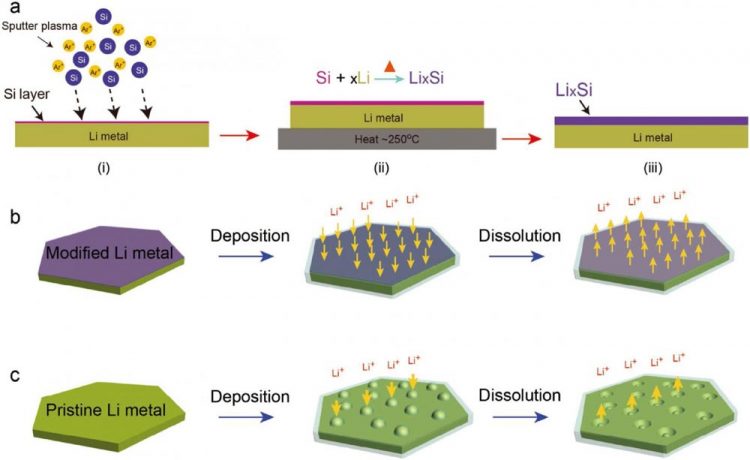A novel approach of improving battery performance

Schematic representation of the preparation process and electrochemical behavior of LixSi-modified lithium foil. Credit: UNIST
This breakthrough has been led by Professor Hyun-Wook Lee in the School of Energy and Chemical Engineering at UNIST in collaboration with the Agency for Science, Technology and Research (A*Star) in Singapore.
Lithium metal batteries are a type of rechargeable battery that has lithium as an anode. Among a number of different cathode materials, lithium metal has the lowest driving voltage and boasts about 10 times more capacity than conventional graphite anodes.
Therefore, it has been gaining much attention as a potential next generation anode material for electric vehicles and large scale energy storage systems.
While lithium metal anode is an ideal candidate for high energy density batteries, fully using it as an anode in commercial cells is still remain elusive.
For example, lithium metal tends to grow into dendritic structures during the continuous charging/discharging processes of a battery, which may result in poor performance. This is because this dendritic structure on the lithium metal surface layer triggers internal short circuits by piercing through the battery separator.
In the study, the research team suppressed dendritic growth of lithium metal anode by coating the lithium foil with a lithium silicide (LixSi) layer. Results showed excellent electrochemical performances in terms of rate capability and cycle stability.
In situ optical microscopic study was also carried out to monitor the electrochemical deposition of lithium on the LixSi?modified lithium electrodes and the bare lithium electrode.
Conventional lithium metal anodes tend to form dendritic structures, which are known to trigger internal short circuits by piercing through the battery separator. However, it is observed that a much more uniform lithium dissolution/deposition on the LixSi?modified lithium anode can be achieved as compared to the bare lithium electrode.
“Our study provides the direct observation on the electrochemical behavior, volume expansion, as well as the lithium dendrite growth of lithium metal anodes,” says Professor Lee. “Applying this in real battery will also help contribute to the commercialization of lithium metal batteries.”
This research has been supported by the Basic Science Research Program through the National Research Foundation of Korea funded by the Ministry of Education. Their findings have been published in Advanced Materials on July 6, 2018.
###
Journal Reference
Wei Tang et al., “Lithium Silicide Surface Enrichment: A Solution to Lithium Metal Battery”, Advanced Materials (2018).
Media Contact
All latest news from the category: Materials Sciences
Materials management deals with the research, development, manufacturing and processing of raw and industrial materials. Key aspects here are biological and medical issues, which play an increasingly important role in this field.
innovations-report offers in-depth articles related to the development and application of materials and the structure and properties of new materials.
Newest articles

NASA: Mystery of life’s handedness deepens
The mystery of why life uses molecules with specific orientations has deepened with a NASA-funded discovery that RNA — a key molecule thought to have potentially held the instructions for…

What are the effects of historic lithium mining on water quality?
Study reveals low levels of common contaminants but high levels of other elements in waters associated with an abandoned lithium mine. Lithium ore and mining waste from a historic lithium…

Quantum-inspired design boosts efficiency of heat-to-electricity conversion
Rice engineers take unconventional route to improving thermophotovoltaic systems. Researchers at Rice University have found a new way to improve a key element of thermophotovoltaic (TPV) systems, which convert heat…



